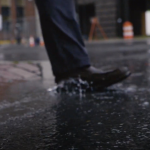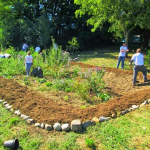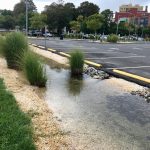New Jersey Future Blog
New Jersey Municipalities Share Green Infrastructure Planning Progress
September 13th, 2021 by Donovan Gayles
Why are towns across New Jersey creating plans for Green Infrastructure?
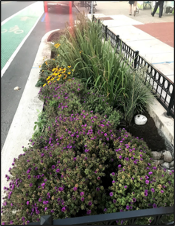
Rain garden in Hoboken, NJ. Source: Green Streets Case Studies.
Have you ever wondered why plots of plants, shrubs, and trees exist in empty parking lots or on the sides of buildings? The issue of flooding and impaired water quality from stormwater—which carries pollutants that negatively affect lakes, rivers, and streams—persists across the state. Managing stormwater will be increasingly difficult due to increased rainfall induced by climate change. Green Infrastructure (GI), however, can help respond to the problem of stormwater runoff. Because stormwater poses a problem in multiple municipalities across the state, New Jersey adopted new stormwater rules that require municipalities to manage stormwater using GI. GI can build upon existing “gray” infrastructure (e.g., pipes) to cultivate a greener state. Utilizing this method will address flooding concerns, while enabling towns to take collective steps toward making communities more sustainable and resilient. Jersey WaterCheck compiles data about GI through several metrics to build transparency in stormwater management across the state.
Why share metrics related to green infrastructure?
Sharing metrics on GI is crucial, because it allows municipalities and communities to get a glimpse of where towns are in their respective green infrastructure implementation. It is no secret that GI has various environmental and social benefits, and each town should be taking steps to use it to improve its stormwater management. If the metrics are posted online and publicly accessible, this data can be used as a benchmark for assessing towns’ progress as well as how much assistance they might need as they use GI to reduce flood risk, improve water quality, and make streets more beautiful.
Findings
The new stormwater rules that went into effect on March 2, 2021 require NJ municipalities to update their Stormwater Control Ordinances (SCOs) to require GI in new major development projects. We examined which municipalities had updated their SCOs as required and which had gone above and beyond the NJDEP’s minimum requirements. We found that several towns, including Princeton, Elizabeth, and Jersey City, have gone above and beyond in their SCOs. These are just a few of the many towns that have exceeded the New Jersey Department of Environmental Protection’s (NJDEP’s) standards in ways such as strengthening the definition of major development and requiring GI for redevelopment projects. Out of the 43 towns surveyed and researched, 28 towns have updated their SCO and 24 have posted these updates on their respective websites. This data can be treated as a benchmark to determine how towns are doing and where they can enhance their planning and implementation of green infrastructure projects.
Are you a municipal representative who has not filled out the survey?
Click here to add your town’s information.
Background
Green infrastructure is a stormwater management strategy that enables stormwater and melting snow to soak into soil where they fall or to be captured for a beneficial reuse, such as irrigation or flushing toilets. It is a way to reuse natural water for environmental benefits. Examples include green roofs, cisterns, and rain gardens. GI can be used to confront the issue of runoff water, which leads to pollution and flooding.
GI is important because it supports the natural environments, public health, and economic development of towns and municipalities. Jersey WaterCheck seeks to increase the transparency of New Jersey’s water infrastructure, including by measuring GI progress.
Process
Jersey WaterCheck uses various metrics to gauge and measure how municipalities are using GI to bring economic, environmental, and social benefits to their communities. Through collaborative efforts, members of New Jersey Future and Jersey WaterCheck have developed several metrics for which data is gathered through municipal surveys. The metrics have been organized in the following categories:
- Stormwater Control Ordinance content, including questions that ask about:
-
- GI for new major development
- GI for redevelopment
- Stormwater Control Ordinance availability, including questions that ask about:
- Whether municipalities have posted GI information on their website
- Current GI use, including questions that ask about:
- Acres of land on which the municipality currently uses GI for stormwater management
- Which towns have shared their MS4 outfall maps with the NJDEP
- Future GI use, including questions that ask about:
- Acres of land the municipality plans to use GI on for stormwater management
- Whether the municipal master plan includes GI goals
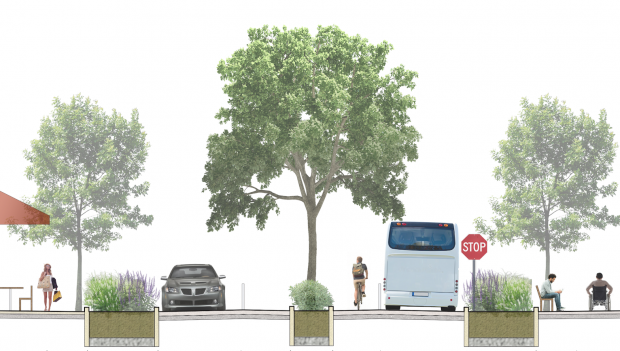
Example of a green street from the Green Infrastructure Municipal Toolkit.
After meeting with various stakeholders, we considered these metrics to be the most important and straightforward to ask towns and municipalities about in reference to GI. After finalizing the list of metrics, we selected 43 towns to survey. We determined these towns based on the following criteria to ensure a diverse sample:
- Coastal, highlands, and pinelands
- Combined and separate sewer system
- Large and small towns
- Towns that do and do not include an overburdened community
- Towns at varying stages of GI implementation
Once the towns were selected and the metrics were finalized, we began the process of gathering information through research and interviews. We connected with these towns via email and telephone to complete the survey.
Overall, it is encouraging to see that many towns have updated their SCOs and that several have chosen to go above and beyond the minimum standard set by the NJDEP. Towns that have not yet updated their SCOs can use the metrics posted on Jersey WaterCheck to learn which towns’ ordinances may serve as good examples. As we take steps towards a greener New Jersey, using metrics to track progress can help keep towns on the road to green infrastructure implementation.
Related Posts
Tags: GI, green infrastructure, JerseyWater Check, new stormwater rules, SCOs, Stormwater, stormwater control ordinances

